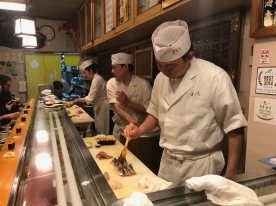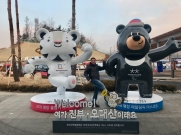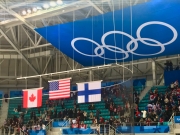A bit of madness is key
to give us new colors to see.
Who knows where it will lead us?
And that’s why they need us!
So, bring on the rebels,
the ripples from pebbles;
the painters, and poets, and plays.
And here’s to the fools who dream…
crazy as they may seem.
Here’s to the hearts that break…
here’s to the mess we make.
It was a hectic couple of days leading up to my departure for this incredible journey. After a snow day, an emotional last day at East Side, and a truly surprising going-away party (thank you mom, dad, and Kim!), I was off to Asia to embark on the opportunity of a lifetime. I was super excited about visiting Japan and moving to Taiwan, but I also became sad about leaving home (for really the first time in my life).
As I sat on the plane, I reflected on leaving everything and everyone that I knew behind. I started to realize exactly what I had gotten myself into, as I was about to move to a country where I did not speak the language, personally knew nobody, and could not even read a menu. After enjoying the in-flight service and reading for a while, I decided to watch a movie, and happened upon La La Land, a movie that claimed the Oscar for Best Picture last year (well, for two minutes, at least). I felt that the beginning of the movie went slowly, and the only reason I did not turn it off was that I was stuck in an aluminum tube for the next twelve hours. I quickly fell in love with La La Land, as it intimately shows the often-untold sacrifices that people need to go through to chase their dreams. And that was before the audition scene:
In a weird way, it was almost like Emma Stone was speaking to me. Other than perhaps Stand By Me, rarely has a Hollywood Blockbuster ever had such a profound impact. I genuinely do believe that traveling is essential “to give us new colors to see,” as Ms. Stone so eloquently sings in this scene. Perhaps most importantly, she reminds us the importance of always striving to approach new situations with an open mind, as “who knows where it will lead us?” Watching La La Land reassured me that everything was going to be alright, and I was ready to take on this world by storm!

After landing at Narita airport right outside Tokyo, I was excited to visit Japan and see Asia for the first time. On my first morning, I got up at 3am to get in line for the Michellin-starred SushiDai restaurant, which was hands-down the best sushi I have ever had in my entire life. After visiting four major cities (Tokyo, Kyoto, Nara, and Hiroshima) and falling in love with Japanese culture and their way of life, I was off to my Fulbright destination: Kaohsiung City, Taiwan.
My first month in Taiwan was really busy, as I had a lot of logistical things to take care of, including securing my apartment, completing all of my immigration paperwork, and adjusting to my new life for the next six months. After meeting my advisor, new colleagues at Kaohsiung Girls High School, and grabbing lunch with some former Fulbrighters, I was off to Taipei to speak at the Fulbright mid-year conference. After touring around the capital of Taiwan for a week, I was so honored to be invited to celebrate Chinese New Year with Michele’s family. During the holiday, all of the schools throughout Taiwan shutdown, and many of my friends took advantage of the extended break to travel internationally. February was definitely the hardest month to get through. Although I had the amazing opportunity to attend the Olympics and watch our women’s hockey team beat Canada to earn a gold medal, there were a lot of tough transitions to get through along the way.
You see, living abroad for an extended amount of time is an incredible experience, but it is not always rainbows and unicorns as Instagram would make us believe. As they told us during our Fulbright orientation, culture shock is a real thing, and there are times when it can be very lonely traveling by yourself (although I always try to make the best of every opportunity). The time change was difficult working through, too, as I almost always had to FaceTime with my friends and family in the morning before they went to sleep. Traveling to Asia also emulated what it must be like to be illiterate, as few signs (outside of airports and subway stations) are in English. On more than one occasion, I ordered something random from a restaurant with no English menu (which was almost always delicious, for the record, but is still an anxiety-causing experience). I may have learned 一點中文 , 我不台外說中文 , but I can still only read about 40 or 50 Chinese characters.
Once March rolled around, I had a bunch of school visits lined up and ready to go. I have learned so much about Taiwanese culture and have grown to love many aspects of this special country. I will definitely miss all of the incredible hospitality, amazing food, and ‘futuristic’ transportation options. I spent every Monday learning from the incredible educators at Kaohsiung Girls High School and enjoyed our weekly “Subway” meetings. I have come to really look forward to every Monday, as we had the chance to talk about education, politics, and yes, even gun violence (a future blog post will consider my thoughts about being abroad during this tumultuous time period in American history). On a serious note, I really cannot thank Hsin-Wei Chen [陳欣薇], Yi-Fan Chen [陳怡帆], Yi-Hsiang Chang Chien [張簡逸翔], Jia-Wei Sun [孫嘉偉], Hsun-Hsun Chung [鍾恂恂], and Hsien-Tsung Lin [林憲聰] enough for everything they have helped me with. 謝謝!

During the Spring, I had the chance to speak at a plethora of conferences and visit a few other countries, as well. The longer I was in Taiwan, the larger my network grew, and I was soon invited to visit schools in every major city. I really appreciate Mr. Chen [陳光鴻], who is leading the effort to implement Phenomenon-Based Learning throughout Taiwan. I held focus groups in Taichung, taught math lessons in Kaohsiung, and visited vocational schools in Tainan. I watched students riding unicycles in Kinmen, and met Taiwanese President Tsai ing-wen in Taipei. Over time, I slowly acclimated to Taiwanese culture (and yes, I had plenty of amazing Taiwanese food at all of the famous night markets throughout the country).

Taiwan is special for countless reasons, but my favorite part can be summarized in three words: mindfulness of others. Although most social norms around personal space can be quite different in Taiwan, people often act with others in mind instead of only thinking about themselves. Take something simple, like letting people pass on an elevator: in the U.S., there are signs everywhere that tell people to stand to the right and let people pass to the left, but people still do not listen. In Taiwan, it seems as though everyone automatically does the right thing to make life easier for everyone else, and it is like that for everything. You can take a nap on a crowded MRT, because people are quiet. Once on the subway, people never sit in the designated priorty seat to make it easier for others that really need the seat (see photo below). The culture of respect creates an unbelievably safe atmosphere that leads to modern day miracles. On countless occassions, I have left my phone, wallet, and Macbook out at a busy Starbucks and no one ever stole it. I have seen people leave their key in the ignition of their scooter, because they have such a deep trust that no one will steal it. When you cultivate a society that is mindful of others, life is better for everyone (even the dogs are rarely leashed, and are always well-trained). We have a lot to learn in the United States, where we value individualism over just about everything else, almost to a fault.
As I wrap up my time here in the Republic of China, I am often asked what I am going to tell my friends and family about Taiwan when I get back to the states. The first thing that I am going to talk about is the amazing Taiwanese hospitality. In the almost 30 countries that I have been privileged to visit, the people of Taiwan are some of the nicest and most welcoming people that I have ever met in my entire life. On a daily basis in Kaohsiung, people will come up to me and say ‘hello,’ and try to help me out in anyway that they can. Sure, the Taroko Gorge was one of the most beautiful parts of nature that I have ever seen, but the true beauty of Taiwan is its people.

Second, albeit controversially, is that I believe now more than ever that Taiwan is unequivocally a sovereign state that deserves the recognition and protection of an independent nation unconditionally. If there is any policy that I agree with the current administration on, it is their support of the Republic of China. Taiwan is a beacon of hope that shares the democratic values of the United States, and we need to ensure that our countries have an enduring friendship that will stand up to geopolitical rivals. Perhaps Director Moy, the de facto United States ambassador to Taiwan, said it best during our end-of-year Fulbright banquet:
In a weird way, my Fulbright experience is like a movie playing before my eyes. On some days, it feels like I have been living in Asia for years. On other days, I feel like it was just yesterday that I was sitting on a plane waiting to take on the world. As they say, maybe “a bit of madness is key, to give us new colors to see. Who knows where it will lead us? And that’s why they need us! So, bring on the rebels, the ripples from pebbles; the painters, and poets, and plays. And here’s to the fools who dream… crazy as they may seem. Here’s to the hearts that break… here’s to the mess we make.”
謝謝 , 台灣![Xièxiè, Táiwān!]
很高興認識你們 , 我學到了很多東西。[Hěn gāoxìng rènshí nǐmen, wǒ xué dàole hěnduō dōngxī.]
我會想你的![Wǒ huì xiǎng nǐ de!]
台灣將永遠在我心中。[Táiwān jiāng yǒngyuǎn zài wǒ xīnzhōng.]






























